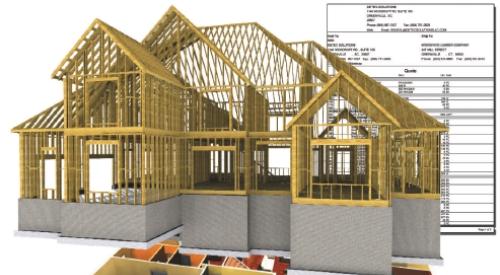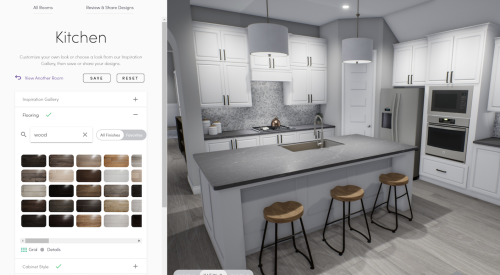Model homes have long served as a key tool in the sales process for home builders. And, as technology has improved, physical homes have slowly given way to computerized ones, culminating in the current trend of 3D home models.
In addition to the advantages of 3D computer modeling and artificial intelligence (AI) for more easily allowing builders to iron out any construction technicalities or design issues before the build starts, 3D technology also allows builders to provide home shoppers with a virtual walk-through of the actual building. This is a powerful tool for conveying a home's design and giving potential buyers the chance to really feel like they are in the space. And, while architects and builders are comfortable reading plans and design documents, homebuyers are rarely well-versed in this skill, so any assistance with visualizing the design is a potent sales tool. Short of visiting an actual physical model home, this level of realism can only be offered by 3D technology.
Increasingly, builders are making use of this 3D design technology, which can do everything from show customers a digital representation of a house or specific detail to experience virtual walkthroughs of a project. It can be a cost-effective alternative to—or a tool used in conjunction with—building physical model homes.
RELATED
- 3D Home Tours Steal the Show Amid Stay-at-Home Orders: See how technology is turning out to be the saving grace for the real estate industry during the coronavirus pandemic
- Seeing the Future of Online Sales: While the human touch will always be essential in home sales, technology can help by enhancing what an online sales consultant can do
- See Change: Innovation in Home Building: Housing may never be truly disrupted, but these technologies offer solutions to help manage its continuing evolution
How Builders Can Make the Most of 3D Models in the Home Sales Process
Since the technology is evolving, many builders are still trying to figure out how to best utilize it. We talked to some home builders who are using 3D design tools to see what their experience has been like. Here are their tips for making the most of 3D home models in your sales process:
1] Inform your customers
Even if you don’t use it in initial meetings, let customers know up front that you have the technology. Obviously, the renderings need to look good, but the simple fact that you use 3D models can set you apart from other builders.
2] Understand how the technology is best used
Just because the technology can do anything doesn’t mean it should. Builders shouldn't go overboard adding features just to show off their modeling software. Keep in mind both your budget and your clients’ budget when building the model.
3] Let customers play
Make the process interactive and let customers play with the technology. Sales centers can feature a range of interactive tech options for buyers: kiosks with tablets, touch-screen computers, and flat-screen TVs let customers peruse all of the options available to them.
4] Keep communicating
Don't just expect to set the technology on autopilot and have it do the work for you. This is an adjunct tool for your business, but your company still needs to have solid design and sales processes in place.
Make sure you check back frequently with clients as the design process progresses. Three-dimensional modeling allows the home to be built exactly to their specifications, so check with clients to ensure they’re happy with the design before moving forward. For example, in a custom home where the homeowner is contemplating a coffered ceiling, say, 3D modeling can enable the builder to model that ceiling in graphic detail for the client, get the client's opinion, and then continue with the process (or change the design, if necessary).
5] Build a database
Build a database of all your products and offerings to be used in conjunction with the models. You can include all of your different models, products, and other options, which allows customers to mix and match as they please while working in the sales center.
6] Leverage the technology over distance
Make sure to talk up the technology with out-of-town buyers. Since the models are already computerized, they can be shared electronically. This could allow an online discussion via services such as GoToMeeting, so clients don’t have to come to you.
7] Encourage exploration
Let your prospects work with the models from the comfort of their home. By featuring 3D models on their websites, builders give prospects the opportunity to really explore product and get to know the company's work. An added perk is that this experience also means customers spend longer exploring your website.
8] Consider accessibility
Consider generating and sharing models as 3D PDFs. This ensures that homebuyers have access because the PDFs can be opened using Adobe Acrobat Reader, a common consumer application, rather than specialized software. Software developer CG Visions, which does BIM (building information modeling) consulting, recommends this approach to all of its home-builder clients as the best way to take customers on a virtual walk-through of the home.
9] Understand compatibility and know the limitations
It's important to know the limitations of the technology beforehand. Not so long ago, a common issue that often caught builders unaware was the incompatibility between Apple's operating system and Adobe Flash Player software used for streaming and viewing video, audio, and multimedia. (In the case of Flash, it reached the end of its support from Adobe at the end of 2019 and HTML5 filled that gap, with more and more websites adopting HTML5.) Those kinds of incompatibilities usually steer decisions regarding which programs your business decides to use.
It's also important to understand that these technologies are not an end unto themselves; they're a tool, which, in the hands of skilled users in companies that have established processes, can have enormous potential.













